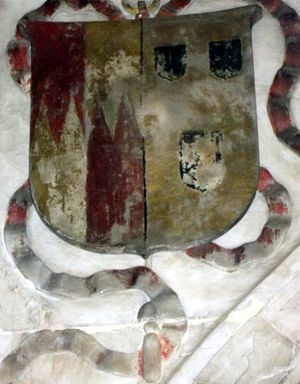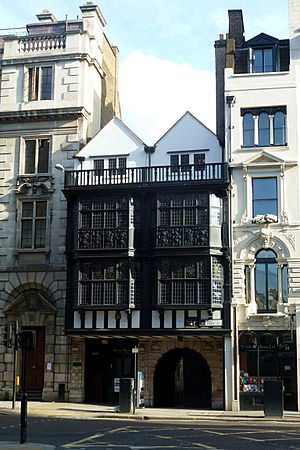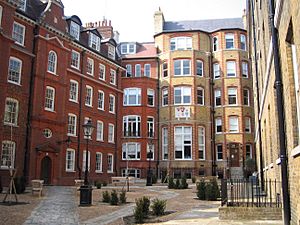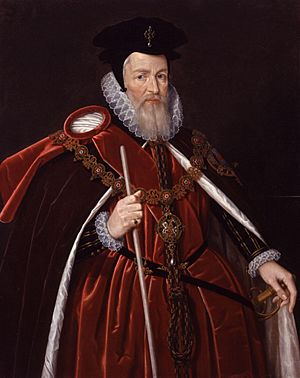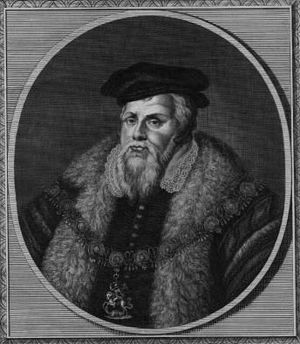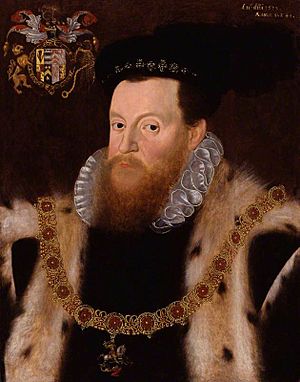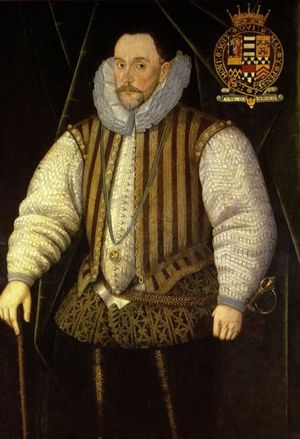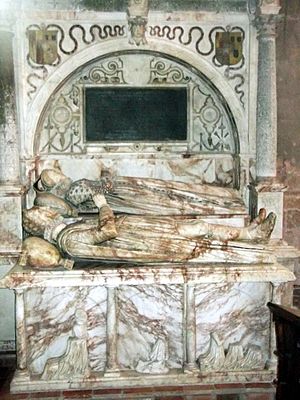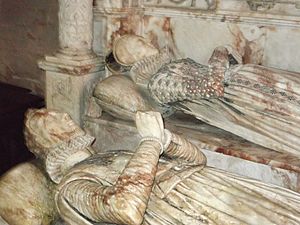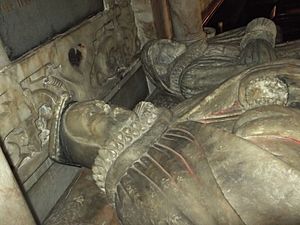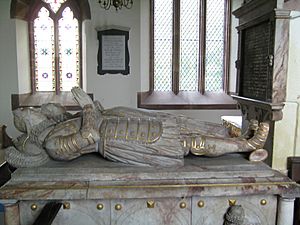George Bromley (politician) facts for kids
George Bromley (around 1526–1589) was an important English lawyer, landowner, and judge during the time of Queen Elizabeth I. He came from a powerful family in Shropshire known for their legal work and land. Even though his brother, Thomas Bromley, became more famous, George Bromley was very important in the areas near Wales and at the Inner Temple, a famous law school. He served as a Member of Parliament (MP) for different places like Liskeard, Much Wenlock, and Shropshire.
Contents
Early Life and Family Background
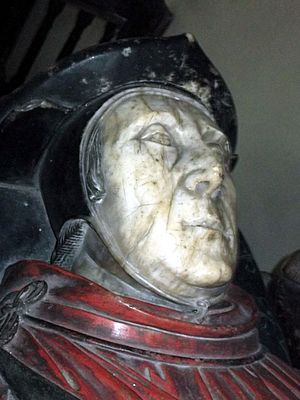
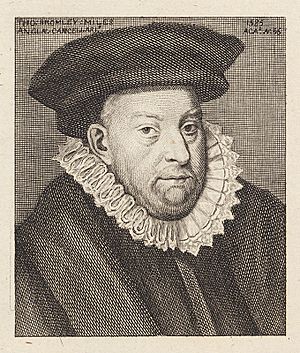
George Bromley was born around 1526. His father, also named George Bromley, was a well-known lawyer from Hodnet. His mother was Jane Lacon from Willey, Shropshire.
George's father was a senior teacher at the Inner Temple law school. He was also a judge for the town of Shrewsbury. His younger cousin, Thomas Bromley, became the top judge in England and Wales. Both cousins had a lot of power in the border areas near Wales. They worked for the Council in the Marches of Wales, which was the government's main group in that region.
Young George Bromley's father died in 1533. George was likely looked after by a guardian. His father's cousin, Chief Justice Thomas Bromley, probably helped him a lot during this time.
The Bromley Family Tree
The Bromley family was very important. They often married into other powerful families like the Hills, Corbets, and Newports. This family tree shows how George Bromley was connected to these families.
| David Browe of Malpas, Cheshire | Jane Mitley | Roger Bromley of Mitley | |||||||||||||||||||||||||||||||||||||||||||||||||||||||||||||||||||||||||||||||||||||||||||||
| Humphrey Hill of Blore and Buntingsdale | Agnes, daughter and coheiress of John Bird of Charlton, Shropshire, granddaughter and heiress of David of Malpas | Unknown, daughter and coheiress of David Browe | Roger Bromley of Mitley | ||||||||||||||||||||||||||||||||||||||||||||||||||||||||||||||||||||||||||||||||||||||||||||
| Thomas Hill | Margaret Wilbraham of Woodhey, near Faddiley, Cheshire | Beatrix Hill | William Bromley of Mitley | Roger Bromley | Jane Jennings of Walliborne Hall, Church Pulverbatch | ||||||||||||||||||||||||||||||||||||||||||||||||||||||||||||||||||||||||||||||||||||||||||
| Sir Rowland Hill (died 1561), of London and Hodnet, Lord Mayor of London | Joanna Hill | John Gratewood | George Bromley of Hodnet, High Sheriff of Shropshire 1521-2 | Jane Lacon of Willey, Shropshire | Elizabeth Dodd of Cloverley, near Calverhall, Shropshire | Thomas Bromley (chief justice) (died 1555) of Eyton on Severn, Wroxeter and Shrewsbury, Chief Justice of the Queen's Bench | Isabel Lyster of Rowton, Shropshire | ||||||||||||||||||||||||||||||||||||||||||||||||||||||||||||||||||||||||||||||||||||||||
| Reginald Corbet (died 1566) of Adderley and Stoke upon Tern, MP for Much Wenlock and Shrewsbury, Justice of the King's Bench | Alice Gratewood, co-heiress of Sir Rowland Hill | Thomas Bromley (1530–87), of Rodd Castle and Hodnet, MP for Bridgnorth, Wigan and Guildford, Lord Chancellor | Elizabeth Fortescue of Shirburn, Oxfordshire | SIR GEORGE BROMLEY (c.1526–89), of Hallon in Worfield, MP for Much Wenlock, Liskeard and Shropshire | Jane Waverton of Worfield | Margaret Bromley | Sir Richard Newport (died 1570) of High Ercall, MP for Shropshire | ||||||||||||||||||||||||||||||||||||||||||||||||||||||||||||||||||||||||||||||||||||||||
| Richard Corbet | Anne Bromley | Elizabeth Bromley | Sir Oliver Cromwell (died 1655) of Hinchingbrooke House and Ramsey Abbey, MP for Huntingdonshire | Sir Henry Bromley (c.1560–1615), of Holt Castle and Shrawardine Castle, MP for Plymouth, Worcestershire and Shropshire | Francis Bromley (c.1556–91), of Hodnet, MP for Shropshire | Sir Edward Bromley (1563–1626), of Shifnall Grange and Bridgnorth, Baron of the Exchequer, MP for Bridgnorth | Francis Newport, MP for Shropshire | ||||||||||||||||||||||||||||||||||||||||||||||||||||||||||||||||||||||||||||||||||||||||
Land and Property
The Bromley family were important landowners in Shropshire. This county did not have many noble families, so the landowners held a lot of power. The Bromleys were not super rich from their land alone. Their wealth came from their education and connections, which helped them get important jobs in government.
George Bromley inherited family lands at Hawkstone and Wistanswick in Shropshire. He also had land in other parts of the county.
He made a smart marriage to Joan Waverton. She was the heiress to the Hallon estate in Worfield. Hallon became George Bromley's home and was passed down to his children. Later, a legal battle meant the Hallon estate went to the Davenport family.
Legal Training and Career
George Bromley trained at the Inner Temple law school and became a lawyer. His younger brother, Thomas, who later became a very important judge, also studied there.
At the Inner Temple, George Bromley was given more and more important roles. He started with ceremonial jobs, like helping organize dinners. Then he moved to more serious tasks, like checking the school's finances and looking after its church.
When Queen Elizabeth I came to power, George's career at the law school sped up. In 1559, he became a "bencher," a senior member of the Inn. He attended meetings often and was very involved.
He quickly received more honors. In 1561, he became the Autumn Reader, a senior teaching role. In 1567, he was elected treasurer of the Inn. As treasurer, Bromley worked to improve the Inn's finances. He made sure people paid their debts and fined those who did not do their duties. This strict approach seemed to work, as he was re-elected treasurer.
Queen Elizabeth's government was worried about Catholic influence among lawyers. In 1577, Bromley was asked to find out which members of the Inner Temple might be Catholic. He did this very carefully, listing 59 names.
George Bromley kept his room at the Inner Temple until he died.
Political and Judicial Career
Early Political Life
By 1554, George Bromley was a steward of crown lands in Shropshire. This shows he was focused on building his career in his home county. He became an MP for Much Wenlock in 1558, during the last parliament of Queen Mary's reign. His brother, Thomas, also became an MP at this time.
The Bromley brothers had powerful relatives who helped them. Their mother's family, the Lacons, had a lot of influence in Shropshire elections. George was elected again for Much Wenlock in 1559, in Queen Elizabeth's first parliament.
In 1563, Bromley was elected MP for Liskeard in Cornwall. This time, he was helped by important people at court, like Francis Russell, 2nd Earl of Bedford, and Lord Burghley, the Queen's closest advisor.
Important Judicial Roles
Under Queen Elizabeth, George Bromley was given many important jobs as a judge and in local government. He became a member of the Council in the Marches of Wales, a powerful government group for Wales and its border counties. He was also made a Justice of the Peace in many counties, including Shropshire and Cheshire.
In 1564, a bishop praised Bromley for his legal knowledge and strong Protestant beliefs. This helped him get promoted quickly. From 1566 to 1580, he was the chief lawyer for the Duchy of Lancaster, a special royal estate. This job gave him a lot of power, especially in northern England.
He also became involved in church matters in 1572. By 1574, he was the senior civil authority in Shropshire. He served as a judge for the Anglesey court circuit and then became a judge for Chester in 1580. He also became a judge for the towns of Worcester, Shrewsbury, and Bridgnorth.
Work with the Council in the Marches
George Bromley was a member of the Council in the Marches of Wales by 1560. This council was very important for governing Wales and nearby English counties. For 26 years, it was led by Sir Henry Sidney, a strong supporter of the Protestant church. Bromley was the council's chief legal officer and earned a good salary.
Bromley sometimes had tasks beyond his legal duties. For example, in 1569, he helped manage weapons and ammunition in Merionethshire. He also helped enforce the new religious rules under Queen Elizabeth. In 1573, he was part of a group that made sure everyone attended church services using the Book of Common Prayer.
Bromley was known for being fair and helping the poor get justice. In 1580, he wrote to his brother, the Lord Chancellor, asking him to help 17 poor men who were being unfairly sued. The council was proud of its efficiency and honesty. In 1581, Bromley helped increase the pay of the clockkeeper at Ludlow Castle, where the council met, because he was so hardworking. When Sir Henry Sidney died in 1586, Bromley led the council until a new leader, Henry Herbert, 2nd Earl of Pembroke, was appointed.
MP for Shropshire
In 1571, Bromley was elected as a Member of Parliament for Shropshire. He was elected again in 1572. These were difficult times, with rebellions and plots against the Queen. The government wanted to make sure only loyal Protestants were elected to Parliament.
As a respected lawyer, Bromley was given important responsibilities in Parliament. He worked on laws about official letters from the Pope and laws about treason. He also helped with issues concerning the Welsh counties. In 1572, he was on committees discussing Mary, Queen of Scots. He also worked on a bill to help Tonbridge School get its finances back in order.
In 1576, Bromley helped question Peter Wentworth, an MP who spoke out about free speech in Parliament and criticized the Queen. Wentworth was sent to the Tower of London because of this. Bromley also helped investigate a case where an MP, Arthur Hall, used his special rights to avoid paying for damages caused by his servant. This case helped Parliament decide it had the right to discipline its own members.
Parliament did not meet again until 1584. At that time, Bromley's oldest son, Francis Bromley, was elected MP for Shropshire.
Judge and Recorder Roles
Bromley became a judge for Chester in 1580, likely with the help of Lord Burghley. He was knighted the month after this appointment.
In 1582, Bromley helped Lady Mary Egerton, who was accused of not attending Anglican church services. He wrote to the bishop and others, asking them to delay her case. His brother, the Lord Chancellor, and other powerful figures also supported her.
However, Bromley was much stricter in the case of Richard Gwyn, a Welsh schoolmaster. Sir George Bromley played a leading role in Gwyn's long imprisonment and questioning. Bromley also led the judges who tried Gwyn in 1584. Gwyn was sentenced to death. He was executed in Wrexham on October 15, 1584. Richard Gwyn was later recognized as a saint by the Pope in 1970.
In 1585, Bromley complained about the poor living conditions provided to him in Chester. He probably had fewer complaints about Shrewsbury, where he became a judge in 1580. He helped with the rules for Shrewsbury School and made sure funds were set aside for university scholarships. The town council valued him highly.
Death
George Bromley died on March 2, 1589. He was buried in St Peter's church at Worfield. His second son, Edward, built an impressive tomb for George and his wife, Joan. The tomb has statues of them.
The words on his tomb say: "Sir George Bromley, Knight, Chief Judge of Chester, and of The Council in the Marches of Wales: a Just man and a Great supporter of the Religion now established, died on the second of March 1588, Aged 63. The said Sir George Bromley and his younger Brother, Sir Thomas Bromley, Knight, Lord Chancellor of England, were the only sons of George Bromley, of Hawkstone, Esq., and of Jane, one of the Daughters of Sir Thomas Lakon, of Willey, Knight."
"The good lady, Dame Jane, wife to Sir George Bromley, Knight, Daughter and sole Heir of JOHN WANNERTON, of Hallon, Gent., Died on November 19, 1606, Aged 73. They Had ten children, six sons and four daughters. The worthy Judge, Sir Edward Bromley, Knight, second Baron of the Exchequer, who kneels here, out of a loving heart, built this monument for his dear Parents."
The tomb was moved in 1866 during a church restoration to make more space.
Marriage and Children
George Bromley married Joan Waverton, the daughter of John Waverton of Worfield. Her name is also sometimes spelled Wannerton. Joan lived longer than George, dying on November 19, 1606, at age 73.
They had ten children, including:
- Francis Bromley: He was George's heir and also served as an MP for Shropshire. He died less than two years after his father. His son, Thomas, died without children. His daughter, Jane, married William Davenport, and their family later gained ownership of Hallon.
- Edward Bromley: He was another important lawyer who became a judge in a special financial court. He inherited the family lands after his nephew died. He also died without children.
- Margaret Bromley: She married Francis Wolryche. Their family later became the Wolryche baronets.
- Mary Bromley: She married George Cotton. Their family later became the Cotton baronets and Viscounts Combermere.
Family Tree: Descendants
George Bromley's Children and Grandchildren
| SIR GEORGE BROMLEY (c.1526–89), of Hallon in Worfield, MP for Much Wenlock, Liskeard and Shropshire | Jane Waverton of Hallon, Worfield | ||||||||||||||||||||||||||||||||||||||||||||||||||||||||||
| Francis Bromley (c.1556–91), of Hodnet, MP for Shropshire | Joyce Leighton of Wattlesborough | Sir Edward Bromley (1563–1626), of Shifnall Grange and Bridgnorth, Baron of the Exchequer, MP for Bridgnorth | Margaret Lowe of Enville, Staffordshire | George Bromley | |||||||||||||||||||||||||||||||||||||||||||||||||||||||
| Roger Puleston of Emral, MP for Flintshire and Denbighshire | Susan Bromley | George Cotton of Combermere Abbey | Mary Bromley | Francis Wolryche of Dudmaston Hall | Margaret Bromley | ||||||||||||||||||||||||||||||||||||||||||||||||||||||
| Thomas Bromley | Jane Bromley | William Davenport | Thomas Cotton | Elizabeth Calveley of Lea Newbold | Sir Thomas Wolryche, 1st Baronet | Ursula Otley of Pitchford Hall | |||||||||||||||||||||||||||||||||||||||||||||||||||||
| Lettice Maddocks of Wolverhampton | Henry Davenport of Hallon | Hester Salusbury, daughter of Sir Thomas Salusbury, 2nd Baronet | Sir Robert Cotton, 1st Baronet, of Combermere | Wolryche baronets of Dudmaston | |||||||||||||||||||||||||||||||||||||||||||||||||||||||
| Davenport family of Davenport House, Worfield | Cotton baronets of Combermere, Cheshire, and Viscounts Combermere | ||||||||||||||||||||||||||||||||||||||||||||||||||||||||||
See also


